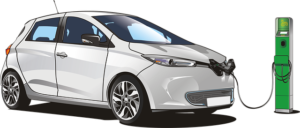WHAT ARE HYBRID ELECTRIC VEHICLES?

Hybrid electric vehicles can play an important role in saving fuel while lowering the risk of pollution emission. Over the years, research initiatives were focused on integrating electrical Powertrain components including Motor, Generator, Battery, and Motor Controller in tandem with Combustion Engines to deliver Hybrid Vehicles. As a result, the different types of hybrid electric vehicles also came into being ever since these became popular.
Hybrid Electric Vehicles essentially utilizes two modes of power source; Fuel and Battery (as a part of Electric Propulsion System), which in turn helps in achieving better fuel economy. Apart from this, Hybrid Electric Vehicles are mainly known for improving efficiency via ‘regenerative braking’ and reducing idle emissions through a ‘start-stop system’.
Through the course of their development, another variant, known as Plug-In Hybrid Electric Vehicles (PHEVs) also emerged that exuberates the characteristics of a conventional Hybrid Electric Vehicle (the combination of IC Engines & Electric Propulsion System) along with Battery Electric Vehicle, having a plug to connect to electrical grid and charge batteries, in addition to regen braking.
Main components of a hybrid electric vehicle
The hybrid electric vehicles, as stated, have become very popular. However, it is necessary to consider different electric propulsion components that complement the IC Engine sub-systems. Some of the main components of the hybrid electric vehicle are as follows:
- Auxiliary Battery
The auxiliary battery is one of the main requirements in a hybrid electric vehicle. Before the tractional battery starts and engages in work, the auxiliary battery serves the main function of powering up the vehicle or auxiliary accessories.
- Electric Generator
The electric generator of an electric vehicle is responsible for generating electricity from the rotation of the wheels. The hybrid electric vehicles may consist of different types of electric generators to serve regenerative and drive functions.
- Traction Motor
While Combustion Engine along with Transmission systems play a central role in driving the vehicle, traction motor acts as another prime mover responsible for propelling the vehicle as the need be. Traction Motors are also responsible for keeping a check with the regenerative drive functions of the vehicle.
- Motor Controller
Motor Controller or Traction inverter is a power unit responsible for managing electricity flow in the vehicle, such as speed control and management. It also controls the produced torque by the traction motor.
- Thermal Cooling System
A thermal cooling system is also a major requirement in electric hybrid vehicles. The hybrid vehicles tend to be heated up. A strong thermal cooling system is responsible for maintaining the temperature of power electronics, motors, and batteries.
- Traction Battery Pack
A traction battery pack acts as an energy storage system and the secondary power source. The in-built Energy Management System (EMS) will let the battery act as a power source once the electric propulsion system kicks in.
How do hybrid electric vehicles work?
The hybrid electric vehicles function using internal combustion energy and an electric motor. The main energy is stored in batteries. However, the hybrid electric vehicle does not need to be plugged in for charging the battery.
Instead, the hybrid electric vehicles have a regenerative braking feature that is responsible for charging the vehicle. Even the internal combustion engine of the hybrid electric vehicle is responsible for charging the vehicle. The main power is offered to the electric motor, which can be beneficial for small engines. The battery of the hybrid electric vehicle can play an important role in reducing auxiliary loads and lowering the engine idling. These play an important role in boosting fuel economy without lowering the performance of the vehicle.
What are the types of hybrid electric vehicles?
There are different types of hybrid electric vehicles that can meet the needs of users.
Over the years, hybrid electric vehicles in India are becoming extremely popular. These vehicles can enhance the impact and can also lower the environmental risks, which is regarded to be one of the main advantages of hybrid electric vehicles.
Well, some of the prominent types of hybrid vehicles include the following.
- Parallel Hybrid
This is one of the most common configurations in hybrid vehicles. The electric motors and gasoline engines are connected to a mechanical transmission. There is no separate generator present in this configuration, instead, the traction motor acts as a generator as per the requirement. Both traction motor and generator support vehicle propulsion in their optimum operating range.
- Series Hybrid
In a series hybrid vehicle, the electric motors provide maximum thrust, thereby avoiding the physical, mechanical connection amongst engines and wheels. The gasoline engine is responsible for recharging the battery via a generator. It plays an important role in enhancing the driving experience through smooth and powerful acceleration.
- Series Parallel
This configuration is also known as Power-Split Hybrid and allows for both gasoline engine and traction motor connected to the transmission. The configuration has a direct impact on the gasoline engine size required to drive the vehicle resulting in overall higher efficiency.

